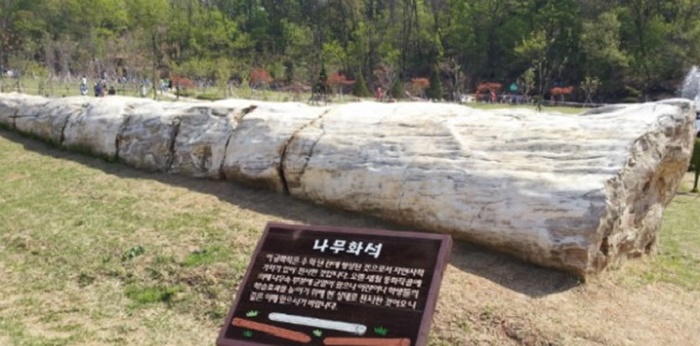
At Paradise Arboretum in Bucheon Nature Ecology Park located in Bucheon city you can see a group of petrified woods with various shpes. These petrified woods are discovered in the Mesozoic Triassic strata in Java Island, Indonesia. These are estimated to be formed 240 ~ 205 million years ago. The longest one is more than 27 meters long. All the mineralogical characteristics of petrified woods are similar to crystal. It has hardness of 6.5 ~ 7.0 with specific gravity of 2.60 ~ 2.65. Major ingredient is silica dioxide, same as crystal. A refractive index of the stone is 1.54. Why don't you take a stroll in a beautiful small park!
Petrified wood is the result of a tree or tree-like plants having completely transitioned to stone by the process of permineralization. All the organic materials have been replaced with minerals (mostly a silicate, such as quartz), while retaining the original structure of the stem tissue. Unlike other types of fossils which are typically impressions or compressions, petrified wood is a three-dimensional representation of the original organic material. The petrifaction process occurs underground, when wood becomes buried under sediment or volcanic ash and is initially preserved due to a lack of oxygen which inhibits aerobic decomposition. Mineral-laden water flowing through the covering material deposits minerals in the plant's cells; as the plant's lignin and cellulose decay, a stone mold forms in its place. The organic matter needs to become petrified before it decomposes completely.
Elements such as manganese, iron, and copper in the water/mud during the petrification process give petrified wood a variety of color ranges. Pure quartz crystals are colorless, but when contaminants are added to the process the crystals take on a yellow, red, or other tint. Following is a list of contaminating elements and related color hues:
carbon – black
cobalt – green/blue
chromium – green/blue
copper – green/blue
iron oxides – red, brown, and yellow
manganese – pink/orange
manganese oxides – blackish/yellow
[Opening hours]
March to October : 09:00 ~ 21:00
November to February : 09:00 ~19:00
Closed on New Year's Day, Seolnal, Choosok and every Monday
* No entrance fee
[To claim this Earth Cache, please answer the following questions!]
- At the cache zone you can find three tall petrified woods laid on the ground. How many pieces is the foremost white petrified wood(Picture in Cache Description) composed of?
- What penetrated wood and replaced the orgional plant material in the process of petrification?
- Go to waypoint WP1, where you can find a beautiful petrified wood that looks like a big chair. Look closely at seat part of the chair-like stone located about knee high! (1)Is the surface of the stone hard & shiny or rough & sandy? (Do not touch!) (2)What color(s) can you see in the stone? (3)What kind of contaminants are added to the petrification process?
- Take photo of your GPS with the petrified woods fountains in the background and upload! (The task is optional but I would highly appreciate if you would do so.)
- Please send the answers to me by message on my profile! You may log as 'Found'. If the answer is not correct, I will contact you.
무릉도원 수목원 나무화석
부천시에 소재하는 부천자연생태공원 무릉도원 수목원에 가면 다양한 형태의 많은 나무화석을 볼 수 있습니다. 이 나무화석들은 인도네시아 자바섬에 위치한 중생대 트라이아스기(2억4천 ~ 2억5백만년전에 생성) 지층에서 발견된 것들입니다. 길이가 가장 긴 것은 27 미터가 넘습니다. 나무화석의 광물학적 특성은 모든 면에서 수정과 유사한데, 경도는 6.5 ~ 7.0 정도이며, 비중은 2.60 ~ 2.65로 물보다 2.5배 이상 무겁다. 주요 성분은 이산화규소(silica dioxide)로 수정과 같으며, 굴절율은 1.54이다. 예쁜 공원에서 산책을 즐겨보시죠.
나무화석인 규화목은 나무의 원래 형태와 구조를 보존한 상태로 실리카(SiO2)가 목질부의 공극을 채워 형성된다. 실리카는 흔히 단백석(蛋白石=오팔)이나 옥수(玉髓)의 형태로 들어가 있다. 나무가 빠른시간에 공기접촉이 없는 습지나 늪지 물속에 묻히거나 화산재등을 빠르게 덮혀서 앞력을 받고 나무들의 조직 사이로 지하에 용해되어 있던 광물의 침전 작용으로 인하여 원래 나무 성분은 다 없어지고 나무 자체의 구조, 조직, 나이테 등이 고스란히 남게 되어 만들어진 바위돌이다.
미세한 구조들이 보존되어 있어 식물종속(植物種屬)의 성쇠, 고식물지리, 고기후, 지질 층위 등에 큰 의미를 갖는 식물화석이다. 규화목에는 목재의 미세한 구조가 보존되어 있어, 고대 식물의 분류나 계통을 알아낼 수 있는 것이 많다. 따라서, 그 연구는 잎이나 열매의 인흔화석(印痕化石) ·화분분석(花粉分析) 등과 더불어 식물화석 연구의 중요한 한 분야를 이루는 것으로, 식물종속(植物種屬)의 성쇠뿐만 아니라, 고식물지리 ·고기후 ·지질층위 등에 커다란 의의를 지닌다.
석화과정에서 물이나 진흙속에 들어 있던 망간, 철, 구리등의 요소가 나무화석에 다양한 색상을 띠게 한다. 순수한 수정은 색이 없지만 불순물이 첨가되면 황색, 적색 또는 다른 색상을 띠게 된다. 아래는 각 불순물이 함유되었을 경우에 나타나는 색상들이다.
탄소 - 흑색
코발트 - 청녹색
크롬 - 청녹색
구리 - 청녹색
산화철 - 적갈색 또는 황색
망간 - 핑크오렌지
산화망간 - 흑색을 띤 황색
[개방시간]
3월 ~ 10월 : 09:00 ~ 21:00
11월 ~ 2월 : 09:00 ~ 19:00
휴무 : 신정, 설날, 추석날, 매주 월요일
* 입장료 없음
[로그하는 방법]
- 캐시존에 가면 아주 기다란 3개의 나무화석이 놓여져 있습니다. 맨앞에 있는 하얀 나무화석은 몇개의 조각으로 구성되어 있습니까?
- 석화되는 과정에서 무엇이 나무를 침투하여 원래의 물질들을 대체하였습니까?
- Waypoint WP1으로 가세요. 그곳에는 아름다운 의자 모양의 나무화석이 있습니다. 무릎 높이에 있는 앉는 자리 모양의 부분을 자세히 관찰하세요. (만지지 마세요) (1)이 암석의 표면은 단단하고 빛이 납니까? 아니면 고르지 않고 까칠합니까? (2)이 암석은 무슨 색을 띠고 있나요? (3)이 나무화석의 생성과정에서 어떤 종류의 불순물이 포함되었을까요?
- 나무화석으로 장식된 분수를 배경으로 당신의 GPS를 찍은 사진을 로그에 올려주세요.(선택사항이지만 사진을 올려주시기를 부탁드립니다.)
- 답을 제 Profile에 있는 메시지창을 이용해 제게 보내주세요. 이제 로그하셔도 됩니다. 답에 문제가 있을 경우 제가 메시지를 드리겠습니다.
(Source)
Bucheon Nature Ecology Park(부천자연생태공원)
Wikidipia
http://omnislog.com/464
Congrats to Jiho Kim on FTF!
| I have earned GSA's highest level: |
 |